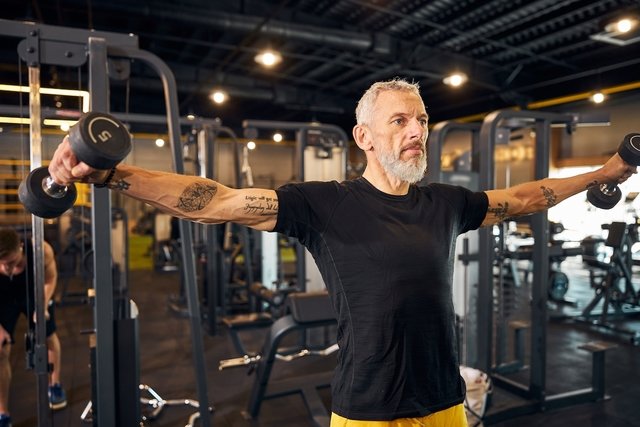The lateral elevation is one of the best exercises to exercise the shoulders, being recommended when strengthening and hypertrophy is desired and to improve the mobility and stability of the joint.
The lateral raise exercise can be done with dumbbells or pulleys and from different positions or inclinations during shoulder training, according to each person’s goals. Learn how to do a complete shoulder workout.
It is important that the lateral raise is initially done with the guidance of a physical education professional, who is best suited to guide its correct performance to make the most of this exercise and avoid injuries.

What is it for
Lateral elevation is indicated for:
- Strengthen and hypertrophy the shoulders;
- Define shoulders and upper limbs;
- Improve mobility and stability of the shoulder joint;
The lateral elevation exercise especially works the deltoid muscles and, therefore, is a great option to complement shoulder training, and can even be done at home. See more exercises for shoulder training at home.
Types of Side Raise
The main types of lateral elevation are:
1. Dumbbell lateral raise
The dumbbell lateral raise is one of the common variations of the lateral raise exercise. It is done using dumbbells that are raised simultaneously to the sides of the body.
2. Seated lateral raise
This type of lateral raise is done using dumbbells and with the person seated. In this position, it is more difficult to move the trunk during the exercise, preventing the person from performing impulses with the body to help lift the dumbbells.
3. Lateral pulley raise
It is a type of lateral elevation done on a gym machine known as a crossover. To do the lateral raise on this machine, the pulley is adjusted to a lower position and the exercise is typically done with one arm at a time.
This exercise has the advantage of maintaining constant tension on the muscles throughout the range of movement.
4. Incline lateral raise
The inclined lateral raise is a type of lateral raise done by slightly tilting the body to one side with the help of a support that is held by one of the arms.
It can be done with dumbbells, pulleys or resistance bands and, due to the incline, it allows for a greater range of movement than the more common form of the lateral raise exercise.
5. Unilateral lateral raise
The unilateral lateral raise is a variation of the simple lateral raise in which one arm is exercised at a time, and can be done in different ways, such as using dumbbells, elastic bands or pulleys.
How to do lateral raises
The step-by-step guide to doing the most common side raise is as follows:
- Standpositioning the feet a little greater than hip-width apart and with the fingertips pointed forward;
- Hold a dumbbell in each hand, placing them next to your legswith palms facing the torso;
- Contract your abdomen well and straighten your torsokeeping the head and spine well aligned throughout the exercise;
- Raise the dumbbells to the sides of the body to shoulder heightkeeping your arms straight or slightly bent;
- Slowly lower the dumbbells until they return to the starting positionalways keeping them next to the body;
- Repeat the movementraising and lowering with dumbbells again.
Furthermore, when lifting the dumbbells, when reaching approximately 60 to 70º of the range of movement, they should be rotated slightly so that their front end points slightly towards the ceiling to reduce the impact of the exercise on the shoulder joint.
Therefore, it is recommended that the lateral elevation is initially done with the guidance of a physical educator so that the movement is done correctly and to avoid injuries.

Sign up for our newsletter and stay up to date with exclusive news
that can transform your routine!
Warning: Undefined array key "title" in /home/storelat/public_html/wp-content/plugins/link-whisper-premium/templates/frontend/related-posts.php on line 12
Warning: Undefined array key "title_tag" in /home/storelat/public_html/wp-content/plugins/link-whisper-premium/templates/frontend/related-posts.php on line 13



